
Quite often rides with low capacity and high thrills are a focal point
of carnival and park midways, drawing more spectators than riders. When
installed in parks often these limited ridership attractions are offered for an additional
fee to offset the operating costs.
|
|
|
 |
| |
|
|
 |
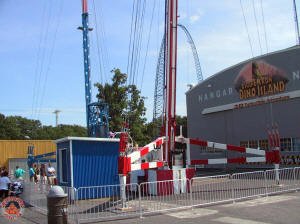 |
 |
| |
|
|
 |
For the 2001 season,
Six Flags Great Adventure added a portable Sling Shot ride as an up
charge attraction. The ride was located in front of the
simulator
theater building. The portable ride manufactured by Funtime Thrill Rides
featured a spring-loaded launch high into the air, and drew big crowds to watch the brave
riders take to the sky.
For the 2003 season, the portable Sling
Shot was replaced by ErUPtion, a park model S&S Sky Sling ride which
offered the same kind of thrills but with higher capacity. The model of
ride suffered several design flaws which meant that it didn't last long,
and was removed after the 2010 season. |
 |
| |
|
 |
 |
| |
|
|
 |
 |
 |
| |
|
|
 |
The start of the 2011 season
at the park saw the ErUPtion replaced with a park model Sling Shot by
Funtime which was larger
and permanently mounted to footers rather than being mounted
on a trailer. The two 177 foot support towers, launch base, and spring
accumulator were all set around a landscaped ride site making the new
installation look much more significant than the trucked-in model.
The installation of the Sling Shot II took several months as the park's
efforts were primarily focused on getting the nearby Green Lantern
standup coaster opened. At the 2011 season premiere, wooden fencing
surrounded the old ErUPtion site and by mid June footer forms were being
assembled. The ride's first steel pieces went vertical by July 4th and by
July 25th the ride was in operation. |
 |
| |
|
 |
 |
| |
|
|
 |
 |
| |
 |
| |
 |
| |
 |
| |
|
|
 |
 |
 |
|
|
|
|
 |
 |
| |
|
|
 |
 |
| |
 |
| |
|
|
 |
Six Flags Great
Adventure's installation of a permanent Funtime Sling Shot came at the
start of a string of purchases by Six Flags with that ride manufacturer.
In 2011, Great Adventure's Sling Shot was purchased along with two Star
Flyers (SkyScreamers) for their parks in St. Louis and at Discovery
Kingdom. The following year Great Adventure would get their own
Star Flyer as well as similar rides at Fiesta Texas and LaRonde.
Magic Mountain would also get a Sling Shot in 2012 although it was a
different model. In 2013, two Star Flyers were added to Six Flags
Over Georgia and Six Flags Over Texas. In addition, a
trailer-mounted Sling Shot was added to Fiesta Texas and a permanent
model (just like Great Adventure's) was added to Mexico. In 2014,
Six Flags New England received a Star Flyer, followed by Mexico in 2015,
Six Flags America in 2017, and Darien Lake in 2019. The Over Texas and New England Star
Flyers were larger towers reaching over 400 feet tall.
|
 |
| |
|
 |
 |
| |
|
|
 |
 |
 |
| |
|
|
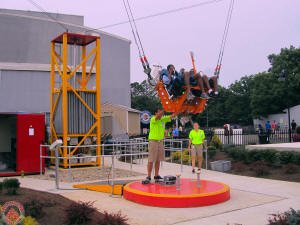 |
The striking orange
and yellow color scheme really highlighted the attraction and drew riders and
spectators to the section of the park at the top of the Boardwalk games area.
Spotlights illuminated the ride's two towers and the rider capsule was
accented with multicolor blinking LED lights which added to the kinetic
vibe of the ride.
The rider capsule had seating which was much more open than the original Sling Shot which was a
ball like cage around the riders. The new seating was unobstructive, and the
attachment points on the sides allowed the car to freely turn as it
bounced up and down on the spring loaded cables.
The summary of the ride below, which is included in Funtime's Sling Shot
Amusement Ride Operation Manual, highlights the ride experience. |
 |
| |
|
 |
 |
| |
|
|
 |
 |
 |
| |
|
|
SLING SHOT DESCRIPTION
The SLING SHOT is a high thrill
amusement ride designed by Funtime Handels Gesmbh.
The SLING SHOT incorporates two towers ranging in height from 36m (120
feet) to 75m (250 feet) and up to 40m (130 feet) apart. The rider
capsule is securely fastened to the ground in a central location between
the two towers. Attached to each side of the rider capsule are two
independent non-rotating 8 mm steel cables. Also attached to the side of
the rider capsule is a swivel fitting and universal joint, this allows
the rider capsule to rotate without twisting the steel ride cable. Each
steel cable passes over a pulley at the top of the tower, two on each
side. The steel cables then pass through a cable guide on the face of
the tower, a deflection pulley at the base of the tower and finally
through a pulley on the top of the spring machine. From this point the
cables run through the pulleys of the spring machine up to a pulley at
the top of the spring machine but on the opposite side to the entry
cable. The cables then continue to the opposite tower via the deflection
pulley at the base of the tower and up through the cable guides, over
the tower top pulleys and finally to a connection on the opposite side
of the gondola.
The rider capsule is attached to the loading platform via a release
mechanism. This release mechanism is a combination of an automatic
safety latch and an electro-magnet.
After the riders have been safely harnessed into their seats, the
operator activates the Launch Cycle of the spring machine. When the
spring machine has tensioned the springs to a predetermined length the
capsule is ready to be released. After a final safety check, the
operator then activates the Magnet release button on the control panel,
which releases the electro-magnet and allows the rider capsule and it’s
passengers to be propelled in a vertical trajectory.
The scale of the ride is so dramatic that the riders can experience up
to 5G’s for a brief moment on take-off, (depending on their weight), and
shortly after, weightlessness, as the rider capsule nears the apex of
the trajectory. The rider experiences acceleration, the rush of wind,
weightlessness and a very exciting “ground rush” as gravity takes effect
and the rider capsule falls towards the ground. This fall is arrested at
approximately 15m (50 feet) from the ground by the spring mechanism in
the spring machine, which again propels the rider capsule vertically,
but this time to a reduced altitude.
After the riders have experienced approximately 4 bounces the
oscillations subside to the point where the rider capsule can be lowered
via the operator pressing the down button on the control panel. During
the initial lowering sequence the spring machine selects normal lowering
speed, 4m (17 feet) before the ground the spring machine automatically
selects a slower lowering speed. Once the slower lowering speed has been
activated the operator controls the descent via foot controls. The
capsule is then guided into locating holes whilst the operator is
standing behind the capsule. The locating holes ensure that the capsule
is returned to its correct position on top of the release mechanism. The
riders are then disconnected from their harnesses and disembark the
launching area.
|
| |
|
|
 |
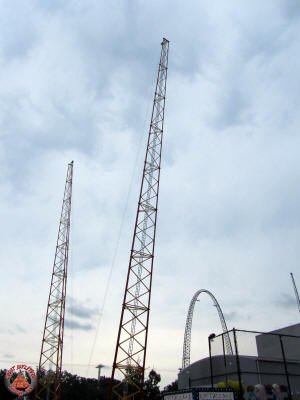 |
 |
| |
|
|
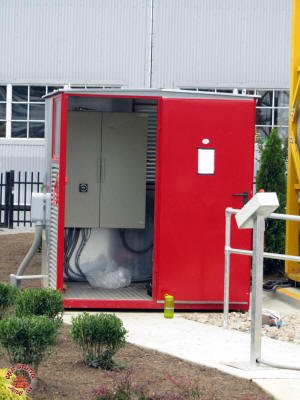 |
Tickets for the Sling Shot cost
$25 per rider in 2011 and the following year saw a two for $40 offer
with an additional discount for season pass holders. Tickets could
be purchased from the nearby Extreme Attractions booth which also
offered tickets for the Great American Road Race go-karts next door. |
 |
| |
|
|
 |
 |
 |
| |
|
|
 |
 |
 |
| |
|
|
 |
 |
 |
| |
|
|
 |
 |
 |
| |
|
|
 |
Outside of the screams of its
riders and the oohs and aahs from onlookers, the operation of the Sling
Shot ride did not generate much sound. The stretching and
compressing of the ride's springs, the movement of the cables through the
pulley system, and the oscillation of the ride capsule all occurred in
near silence. It was the visual of guests being shot vertically
towards the clouds which was the selling point of the Sling Shot. |
 |
| |
|
|
 |
 |
 |
| |
|
|
 |
 |
 |
| |
|
|
 |
 |
 |
| |
|
|
 |
 |
 |
| |
|
|
 |
 |
 |
| |
|
|
 |
 |
 |
| |
|
|
 |
The Sling Shot operated for four
seasons before receiving a sign to identify the ride's name.
Oddly, in 2015 four large Sling Shot signs were added all at once.
Two were located on a ride support building towards the rear of the
ride's site and one along the metal fencing in front of the ride.
In addition, a canvas banner helped to hype the attraction with key stats
including "Over 200 Feet Up," "Over 60 MPH," "4.5G Launch," and "Extreme
Thrill." |
 |
| |
|
|
 |
 |
 |
| |
|
|
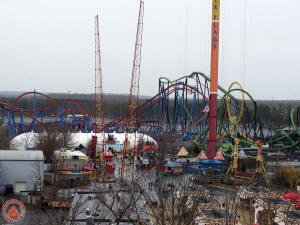 |
 |
 |
| |
|
|
 |
 |
 |
| |
 |
| |
|
|
 |
Over the years, three rides have
been installed in front of the simulator theater, all offering a similar
thrill experience. Each time, the ride has upped the fun level of
its predecessor. Needless to say, the current Sling Shot (aka
Sling Shot II) is the latest and greatest of this type of unique
attraction at Six Flags Great Adventure. |
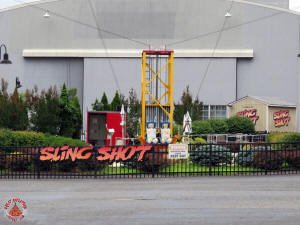 |
| |
|
|
 |
 |
 |
| |
|
|
| Original
Spotlight: September 23, 2021. GAH Reference#: PAID-2011-001 |
| |
|
|
 |
 |
 |
 |
 |
 |
 |



